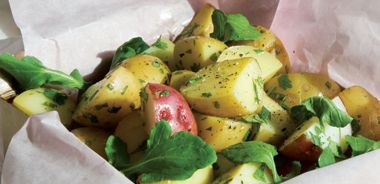Potato and Arugula Salad with Mustard and Roasted Garlic Dressing

2 heads roasted garlic
Olive oil for drizzling over garlic
3 Tbsp (45 mL) sherry or red wine vinegar
1 shallot, finely chopped, soaked in ice water for 30 minutes and drained
2 tsp (10 mL) Dijon mustard
1/2 tsp (2 mL) salt
1/2 tsp (2 mL) pepper
3 Tbsp (45 mL) olive oil
2 lb (1 kg) small potatoes
1/2 cup (125 mL) red wine vinegar
1/2 tsp (2 mL) salt
1 bunch arugula, trimmed
Roast garlic: preheat oven to 350 F (180 C); slice pointed tops off two heads of garlic to expose cloves inside; place heads on tinfoil and drizzle oil over top; wrap heads tightly in foil; bake for 40 minutes or until garlic is soft; remove from oven, unwrap, and allow to cool.
Make dressing: squeeze garlic out of cloves into food processor. Add vinegar, shallot, mustard, salt, pepper, and olive oil and blend together. Taste and adjust seasonings if necessary.
Scrub potatoes well. Cut in half, if necessary, so they’re about 1.5 in (4 cm) in diameter. Place in large pot of water with vinegar and salt. Bring to boil and cook for 20 minutes or until tender. Drain.
Combine dressing with hot potatoes. Cool for five minutes.
Arrange arugula in shallow bowl and spoon potatoes and dressing on top. Toss lightly. Serve warm or at room temperature. Makes 6 to 8 servings.
Each serving contains:
198 calories; 4 g protein; 7.2 g fat (1 g sat. fat, 0 g trans fat); 31.8 g carbohydrates; 2.7 g fibre; 420 mg sodium
Reprinted from HeartSmart Cooking for Family and Friends by Bonnie Stern with permission of Random House Canada. Bonnie Stern’s latest book is Friday Night Dinners (Random House, 2008).
source: "Nutritious crispy chicken meals", from alive #320, June 2009




